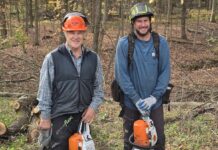SUGARCREEK, Ohio – Generation by generation, cow by cow, barn by barn, the Deetz family farm has morphed into a sprawling, successful operation in Ohio’s dairy corridor.
The family doesn’t seek recognition or compare itself to other farms. They keep it simple, striving just to have an operation they’re proud of, one they can pass down to their young children should they someday get that familiar itch to farm.
Setting the course. The road stretching in front of the barn was nothing but a dirt path in 1898 when Jacob Maurer purchased the farm in Sugarcreek, Ohio.
In that single sale, Jacob set the course for the next four generations. Each would add its own touches, putting up silos, taking them down, building new barns, tearing apart old ones.
By the late 1960s, the soon-to-be fifth generation farmer, Bill Deetz, was napping in a playpen in the parlor while his mom, Thelma, milked.
When he was no longer content looking at the farm through bars, Bill’s father, Galen, plopped him on a tractor baling hay and told him to just make sure the tractor went straight. It didn’t matter that even when young Bill stretched his leg as long as it would go, his big toe was still inches from the pedal. Once they got to the end of the row, Galen would climb from the wagon to the front of the tractor, turn it around and get Bill going on another straight path.
Although the neighbors gawked with disapproval, Bill loved every moment.
Even his first paying job on the farm, picking thistles for a penny, fed his love of farming, and by the time he graduated high school, he eagerly stepped into line as the family’s next farmer.
Ten years’ difference. The farm’s changed more in the past decade, with Bill and his wife, Tina, at the helm, than it had in the last four generations combined.
Stopping by 10 years ago, you would’ve seen a beleaguered Bill who didn’t have time to say much more than “hello” before he was off to milk 200 cows, repair the planter, finish one last field and check on the heifer about to calve … all before dark.
You would’ve seen a man who’d grimace if you had the audacity to say the words “vacation” or “relax.”
Stop by today and Bill might not even be there. Instead, catch him coaching a youth basketball team. Catch him dropping the kids off at 4-H meetings or piano lessons. Catch him on the Serenade of the Seas cruising the Caribbean. And all this with more than double the number of milking cows, 417 to be exact.
The past 10 years of slow expansion forced Bill to realize he couldn’t do it alone. He had only so many moments in a day, only so many places he could be at once and only so much energy. He needed help; he needed to learn how to give up some control and hire more workers.
Soon it became a loop: The more he relied on employees, the more attention he paid to how he treated them so they’d stay, and then the longer they stayed, the more he learned to trust and depend on them. And this all meant he was finally able to entrust his farm to someone else when he needed family time.
Now, the farm’s more productive than ever and, at the same time, Tina says her husband doesn’t miss their three children growing up.
The team. Bill relies heavily on his three managers.
Jerry Miller grew up down the road from the farm and his father worked for Bill’s father. Now, Miller is the mechanic and in charge of planting the 700 acres of corn and 400 acres of hay. And his son, Kevin, comes along, too, to feed calves.
Kirk Henry, the feed manager, has been by Bill’s side monitoring moisture and forage quality ever since there were just 200 cows, and he calls the transition to more cattle “excellent.”
The third manager is herdsperson Tammie McCahill, who says she “loves the ladies.” She milks, does heat checks, administers vaccines, works with the artificial insemination technician and is proud the herd’s averaging 89 pounds.
Although having managers is a change since his father’s farming days, Bill says the biggest difference is his reliance on Hispanic labor.
The language is a barrier, Bill said, but once the workers get in the parlor, they know exactly what to do. They’re dependable, enthusiastic and want as many hours as Bill will give them.
“When we don’t have good employees in the parlor, things aren’t going well,” Tina said.
But there are good employees in the parlor now, and that’s why Bill and Tina recently took everyone out for steak dinners to celebrate hitting the highest milk production their bulk tank’s ever seen.
Future and forever. Doubling the herd has taken the better part of the last decade. All the growth, except for one semiload of heifers, came from within.
They slowly added heifer barns, freestalls, a new machinery shed. They added an employee lunchroom and switched from upright silos to bunkers.
They still have more expansion ideas, but they aren’t sure what to do with them.
Their facilities are already full, and then there’s the land prices and competition to get any spare acre. There are the hills that box in their farm. And then there are the neighbors concerned about manure.
At 38 and 36 years old, Bill and Tina want to think they’ll be here forever, but nothing is certain.
“It’d be nice to know what our kids want,” Tina said.
“You would like to think they’ll want to stay here, but 10 years down the road we don’t know. The boys, at 6 and 9, say ‘yes they want to farm,’ but they also want to be a paleontologist and fireman.”
Many years still stretch between little boys’ dreams and reality, but Bill and Tina don’t want to take any chances.
“We inherited a productive and profitable farm. We give glory to God and to [Bill’s] parents,” Tina said.
“We want to be able to hand this to our kids if they want it, too: a productive, profitable farm for them and their families as well.”
(Reporter Kristy Hebert welcomes feedback by phone at 800-837-3419, ext. 23 or by e-mail at khebert@farmanddairy.com.)
Get 4 Weeks of Farm and Dairy Home Delivered









